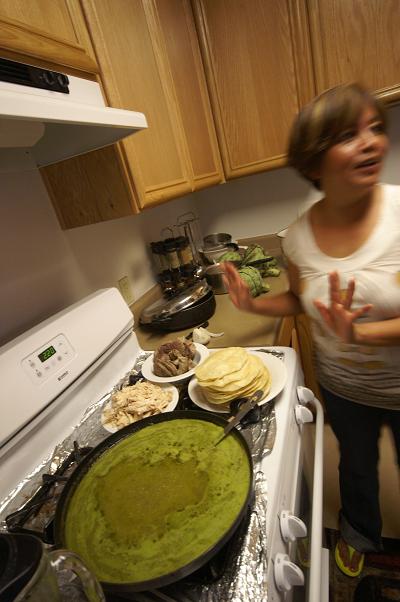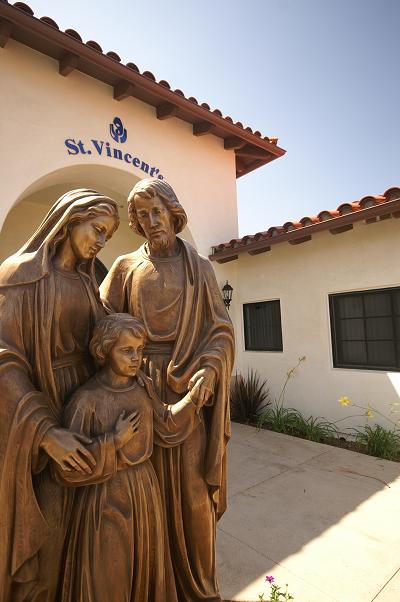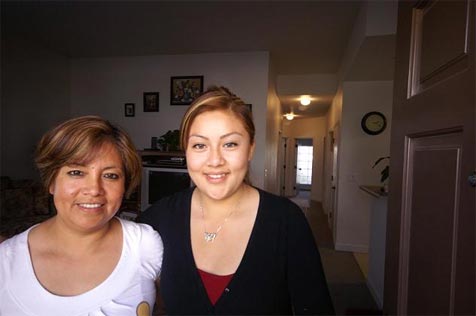Subsidized. Affordable. Beautiful?
St. Vincent's Gardens and Villa Caridad Welcome Santa Barbara's Low-Income Families

(Above: Delfina Nu±es cooks enchiladas in her kitchen at St. Vincent’s Gardens.)
One afternoon not too long ago, the peppery aroma of salsa verde wafted out of Delfina Nu±es’s kitchen, floating over soon-to-be-boiled artichokes and the meat and tortillas that would become the evening’s enchiladas. It spilled out of the large living room, where her husband’s miniature car collection covered every open surface, down the hall past her flower-covered altar to the Virgin, and into each of her family’s three bedrooms, eventually wafting out toward the plastic tricycle on the back patio. Like families everywhere, Nu±es and her 17-year-old daughter Claudia were getting dinner ready. But as they performed this otherwise mundane daily task, mother and daughter were beaming with joy, smiles spreading constantly from ear-to-ear, nearly giggling as they worked.
They couldn’t cork their bubbly happiness because, just a few months before, the Nu±es family-which also includes a seven-year-old boy with asthma, a five-year-old boy with autism, and the father, who works all day in “the factory”-was crammed into a two-room Ladera Street apartment on Santa Barbara’s Westside. Nu±es had lived there for 12 years, with little hope of ever leaving. But then, she says, the Virgin intervened-they’d been one of 75 lucky families who won the lottery to rent apartments at St. Vincent’s Gardens, the new affordable housing complex that started taking in residents just before Thanksgiving 2007.

“We’re very happy,” said Nu±es as she apologized for the mess that wasn’t there. “I love it.” At her old place, her children always wanted to go outside to play, because there was no room inside. “Over here, there’s space,” she said. “It’s very calming, very relaxing.”
Along with the 95-unit Villa Caridad for low-income seniors, the beautifully designed complex at the corner of Calle Real and Highway 154 is the largest affordable housing development in the history of Santa Barbara. With the population on the nearly 20-acre site estimated to be approaching 500 people once everyone’s settled-some seniors are still moving in-the St. Vincent’s development is already shining as a symbol of subsidized housing done right. And in a regional climate where not-in-my-backyard activists have managed to escalate fears about low-income residents and higher density to the forefront of the civic debate, many are staring at St. Vincent’s to see what happens.
“It’s not in my backyard. It’s in my front yard,” explained Sister Alicia Martin, the executive director of the project who lives on the property with four other nuns from the Daughters of Charity. “When you look at this, it doesn’t look like affordable housing.” So far, she can only report the usual problems with multi-family complexes: a neighbor’s music being too loud and someone parking in your spot.
Her order, founded in Paris by St. Vincent de Paul in 1688, came to Santa Barbara in 1858 to “respond to the needs of the community.” For years, that meant teaching the children of ranchers, boarding students, housing orphans, and then, starting in 1935, the sisters began taking care of the developmentally disabled. When that program was disbanded in 1995-due to the “mainstreaming” of the disabled by putting them in small group homes-the sisters polled the community, and the response was unanimous: We need somewhere cheaper to live.
So in 1997, Sister Alicia partnered with Mercy Housing of California, the affordable housing-minded nonprofit that funded the development. The project brought together the City and County of Santa Barbara, and both governments pledged to make it happen quickly. That was more than a decade ago. “They tell me in Santa Barbara that we’re on the fast-track,” laughed Sister Alicia, “and this is 11 years already.” (In the meantime, St. Vincent’s moved forward with a child care center and a residential program for single mothers on welfare or at the risk of going on it.) The groundbreaking for the housing development was on September 27, 2004, but delays ensued, namely the restoration Cieneguitas Creek. Then finally, more than three years later, the 170 lottery winners-who had their names pulled from a crowd of more than 500 applicants-showed up with their stuff.
So who are the lucky ones that now get to pay as little as $664 a month for the two-bedroom units and a max of $836 for four-bedroom units? It depends on how many people are in your family-for two, the maximum household income can’t be more than $31,560; for nine people, the max is $46,050. (For the senior citizens, you must be older than 62 and have an income of less than $23,050 for singles and $26,300 for couples, and the rent will never exceed 30 percent of your income.)
“People have to re-qualify on an annual basis,” explained Darick Fernandez of the John Stewart Management Company, which currently manages the property, but their Incomes can grow up to 40 percent in any given year. Demographically, the residents are locals-89 percent of those living in the four-plexes and duplexes that make up St. Vincent’s Gardens are from Santa Barbara and 90 percent of the seniors at Villa Caridad are from here. “And some,” said Sister Alicia, “were living in their cars.”
The official ribbon-cutting won’t happen until the final infrastructure improvements are made to Calle Real and the grassy playing fields are finished, but life at St. Vincent’s is already in full swing. On a visit last month, kids were playing in the numerous centrally placed jungle gyms, dogs were being walked, people could be seen sitting on their ranch-like porches, kids were napping at the Casa Alegria childcare facility, and there was movement in and out of the two community centers, one in each complex. In Villa Caridad, which is more hotel-like than the condo-ish St. Vincent’s Gardens, seniors were walking the grounds and relaxing on their balconies. There’d been a popular Easter egg hunt a couple weeks before, and the community was starting to gel.

Delfina Nu±es is just one of St. Vincent’s many happy faces. Inside her tasty-smelling home, Nu±es nearly kneeled before the humble Sister Alicia, saying repeatedly, “Thank you for the opportunity to be here.” The nun simply smiled modestly and kept walking through the new model community that she’s helped build.
“We want to have our own little village,” she said near the administration building that now houses the statue of St. Vincent and stained glass of St. Barbara, both more than 100 years old, “a little village with all the amenities to make our residents self-sufficient, to make them contributing members to society rather than a burden.” It may be early in the new history of St. Vincent’s, but Sister Alicia is off to a good start.



